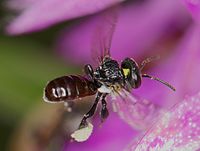
Wild bees respond complementarily to ‘high-quality’ perennial and annual habitats of organic farms in a complex landscape
Sign Up to like & getrecommendations! Published in 2018 at "Journal of Insect Conservation"
DOI: 10.1007/s10841-018-0084-6
Abstract: Agricultural intensification leads to large-scale loss of habitats offering food and nesting sites for bees. This has resulted in a severe decline of wild bee diversity and abundance during the past decades. There is an… read more here.
Keywords: organic farms; wild bees; complex landscape; high quality ... See more keywords

Controlling the impact of the managed honeybee on wild bees in protected areas
Sign Up to like & getrecommendations! Published in 2018 at "Scientific Reports"
DOI: 10.1038/s41598-018-27591-y
Abstract: In recent years, conservation biologists have raised awareness about the risk of ecological interference between massively introduced managed honeybees and the native wild bee fauna in protected natural areas. In this study, we surveyed wild… read more here.
Keywords: protected areas; wild bees; controlling impact; managed honeybee ... See more keywords

Attractiveness of wildflower mixtures for wild bees and hoverflies depends on some key plant species
Sign Up to like & getrecommendations! Published in 2018 at "Insect Conservation and Diversity"
DOI: 10.1111/icad.12264
Abstract: Agricultural intensification is considered to be a major driver of terrestrial biodiversity decline. Resulting loss, isolation and degradation of flower‐rich habitats are threatening pollinators. Agri‐environmental schemes (AES) aim to counteract these negative effects, including measures… read more here.
Keywords: bees hoverflies; seed; wild bees; plant ... See more keywords

Wild bees and their nests host Paenibacillus bacteria with functional potential of avail
Sign Up to like & getrecommendations! Published in 2018 at "Microbiome"
DOI: 10.1186/s40168-018-0614-1
Abstract: BackgroundIn previous studies, the gram-positive firmicute genus Paenibacillus was found with significant abundances in nests of wild solitary bees. Paenibacillus larvae is well-known for beekeepers as a severe pathogen causing the fatal honey bee disease… read more here.
Keywords: wild bees; honey; foulbrood; bee ... See more keywords

Pollen Resources Stored in Nests of Wild Bees Xylocopa ciliata Burmeister and Megachile pusilla Pérez (Hymenoptera: Anthophila) in a Temperate Grassland-Forest Matrix
Sign Up to like & getrecommendations! Published in 2018 at "Sociobiology"
DOI: 10.13102/sociobiology.v65i4.3470
Abstract: Pollen analysis was employed to study the diet composition of two wild bees in a patch of temperate grassland invaded by exotic plants. Thirty pollen types from 14 families and two unidentified types were present… read more here.
Keywords: wild bees; megachile pusilla; ciliata burmeister; temperate grassland ... See more keywords

Possible Epigenetic Origin of a Recurrent Gynandromorph Pattern in Megachile Wild Bees
Sign Up to like & getrecommendations! Published in 2021 at "Insects"
DOI: 10.3390/insects12050437
Abstract: Simple Summary Gynandromorphs, i.e., individuals with a mix of male and female body parts, are known for many species of insects and other animals with separate sexes. This anomaly is generally regarded as the result… read more here.
Keywords: insects; wild bees; male female; gynandromorphs ... See more keywords